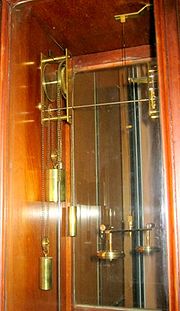
Beverly Clock
Encyclopedia


Clock
A clock is an instrument used to indicate, keep, and co-ordinate time. The word clock is derived ultimately from the Celtic words clagan and clocca meaning "bell". A silent instrument missing such a mechanism has traditionally been known as a timepiece...
situated in the foyer
Foyer
A foyer or lobby is a large, vast room or complex of rooms adjacent to the auditorium...
of the Department of Physics
Physics
Physics is a natural science that involves the study of matter and its motion through spacetime, along with related concepts such as energy and force. More broadly, it is the general analysis of nature, conducted in order to understand how the universe behaves.Physics is one of the oldest academic...
at the University of Otago
University of Otago
The University of Otago in Dunedin is New Zealand's oldest university with over 22,000 students enrolled during 2010.The university has New Zealand's highest average research quality and in New Zealand is second only to the University of Auckland in the number of A rated academic researchers it...
, Dunedin
Dunedin
Dunedin is the second-largest city in the South Island of New Zealand, and the principal city of the Otago Region. It is considered to be one of the four main urban centres of New Zealand for historic, cultural, and geographic reasons. Dunedin was the largest city by territorial land area until...
, New Zealand
New Zealand
New Zealand is an island country in the south-western Pacific Ocean comprising two main landmasses and numerous smaller islands. The country is situated some east of Australia across the Tasman Sea, and roughly south of the Pacific island nations of New Caledonia, Fiji, and Tonga...
. The clock is still running despite never having been manually wound since its construction in 1864 by Arthur Beverly.
The clock mechanism is driven by variations in atmospheric pressure
Atmospheric pressure
Atmospheric pressure is the force per unit area exerted into a surface by the weight of air above that surface in the atmosphere of Earth . In most circumstances atmospheric pressure is closely approximated by the hydrostatic pressure caused by the weight of air above the measurement point...
and by daily temperature
Temperature
Temperature is a physical property of matter that quantitatively expresses the common notions of hot and cold. Objects of low temperature are cold, while various degrees of higher temperatures are referred to as warm or hot...
variations; of the two, the temperature variations are the more important. Either causes the air in a one cubic-foot air-tight box to expand or contract, pushing on a diaphragm
Diaphragm (mechanics)
In mechanics, a diaphragm is a sheet of a semi-flexible material anchored at its periphery and most often round in shape. It serves either as a barrier between two chambers, moving slightly up into one chamber or down into the other depending on differences in pressure, or as a device that...
. A six-degree Celsius temperature variation over the course of each day creates enough pressure to raise a one-pound
Pound (mass)
The pound or pound-mass is a unit of mass used in the Imperial, United States customary and other systems of measurement...
weight by one inch (energy extracted = .11 joule
Joule
The joule ; symbol J) is a derived unit of energy or work in the International System of Units. It is equal to the energy expended in applying a force of one newton through a distance of one metre , or in passing an electric current of one ampere through a resistance of one ohm for one second...
s), which drives the clock mechanism. It is not therefore an example of perpetual motion
Perpetual motion
Perpetual motion describes hypothetical machines that operate or produce useful work indefinitely and, more generally, hypothetical machines that produce more work or energy than they consume, whether they might operate indefinitely or not....
.
A similar commercial example of this mechanism is known as the Atmos clock
Atmos clock
Atmos is the brand name of a mechanical clock manufactured by Jaeger-LeCoultre in Switzerland which does not need to be wound manually. It gets the energy it needs to run from temperature and atmospheric pressure changes in the environment, and can run for years without human intervention.Its...
.
Whilst the clock has not been wound since it was made by Arthur Beverly in 1864, it has stopped on a number of occasions: when its mechanism needed cleaning; when there was a mechanical failure; when the Physics Department moved to new quarters; and on occasions when the ambient temperature has not fluctuated sufficiently. After environmental parameters readjust, the clock begins operating again.
See also
- Oxford Electric BellOxford Electric BellThe Oxford Electric Bell or Clarendon Dry Pile is an experimental electric bell that was set up in 1840 and which has rung almost continuously ever since. It is located in the foyer of the Clarendon Laboratory at the University of Oxford, England...
(1840) - Pitch drop experimentPitch drop experimentThe pitch drop experiment is a long-term experiment which measures the flow of a piece of pitch over many years. Pitch is the name for any of a number of highly viscous liquids which appear solid, most commonly bitumen...
(1927) - Cox's timepieceCox's timepieceCox's timepiece is a clock developed in the 1760s by James Cox. It was developed in collaboration with John Joseph Merlin . Cox claimed that his design was a true perpetual motion machine, but as the device is powered from changes in atmospheric pressure via a mercury barometer, this is not the case...

